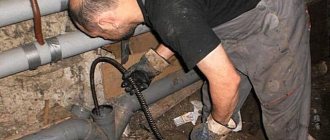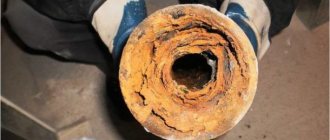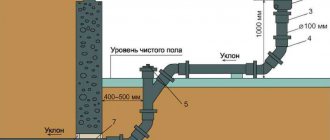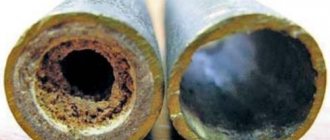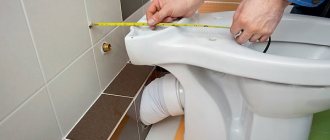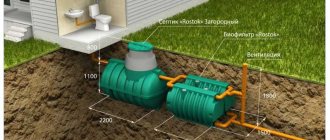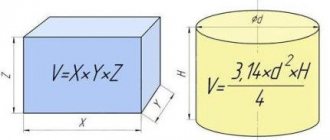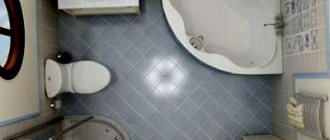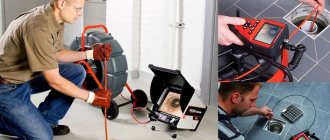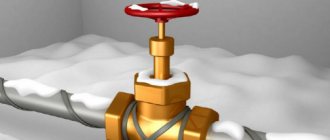Signs and causes of clogged drains
Characteristic signs of blockage in the pipeline are a disgusting odor from the sink or bathtub drain and the characteristic “gurgling” of water when draining. The water does not drain well, and a cloudy, dirty liquid appears near the drain hole.
The causes of blockage are different:
- accumulation of fats on the internal surfaces of the pipe, especially when clogged in the kitchen, which gradually narrows the drainage clearance;
- settling of heavy elements of hard water on the walls of the drainage system, which contributes to the formation of a layer of lime;
- getting into the drain of garbage - leftover food, hair, tea leaves, vegetable peelings, children's toys and even diapers;
- siphon fullness;
- damage or bending of the drainage system;
- improper installation of sewerage - too low a slope, joining at a right or sharp angle;
- accumulation of rust on the inner walls of the metal pipeline due to wear;
- improper maintenance of the drainage system.
The main signs of a clogged drain
It is the signs of a clogged riser that will indicate that not the most pleasant work will soon be done. Let's look at three main signs:
- Unpleasant odor from the drain hole. This is due to the fact that all the aromas cannot pass further through the sewer, but “delight” all the guests of the house with their presence.
- Delay in water drainage from plumbing fixtures. Due to the fact that water is retained in the riser, it cannot be quickly removed from the sink or toilet. In this case, cleaning is also necessary.
- Emerging traffic jams. This is a situation where, when you open a kitchen tap, dirty water with a bad odor rises from a low-lying hole in the bathtub. This indicates that the blockage is accumulating deep in the system.
We already know the signs and causes, let’s figure out how to clean it if the sewer riser is clogged .
How and with what to determine the location of the blockage
To choose the right way to remove the blockage, you will need to determine its location. Most often, the siphon, bends and turns of the pipe, and the junction with the riser of an apartment building become clogged.
Plumbers locate the plug using a special metal cable, sometimes with video surveillance. To determine the location of the blockage yourself, you need to turn on the water or flush it in the case of a toilet, and observe exactly how it drains.
If the liquid leaves slowly, most likely, the blockage occurred at a distance of a meter and a half from the drain point. If the drainage of liquid stops at a certain level, the area between the siphon and the first bend of the pipe is clogged. If the liquid does not leave at all, then the siphon is most likely clogged.
In the case of a plastic pipeline, you can illuminate it with a powerful flashlight.
There will be a darker area where the clog occurs. Pay attention to the corrugated hose; debris often accumulates in it.
If you find that water is standing in all the existing plumbing and even comes when the tap is closed, urgently call a specialist, since most likely the central riser is clogged, which threatens a flood.
What is the reason
The causes of clogged sewers in an apartment building are most often due to improper operation of the system. Any multi-storey building has as many risers as there are apartments on the site. They are connected in the basement into one horizontal line that flows into the yard sewer line. The more subscribers use one line, the greater the likelihood of congestion or traffic jams.
example of a blockage
The sewer becomes clogged for two reasons:
- the appearance of fatty deposits in the pipe;
- foreign objects entering the sewer system.
Fat deposits enter the internal cavity along with kitchen drains and gradually accumulate in areas of changes in thickness, diameter, and changes in the direction of the pipeline. The main danger lies not so much in the layers themselves, which rarely clog pipes, but in their sticky texture. If any object, even the smallest one, gets into the pipe, it will stick and remain on the surface of the layers. Gradually, there will be more of these objects, a plug will form, which will increase in size and one day completely block the entire cross-section of the pipe.
In addition, pipes often become clogged for the following reasons:
- throwing food waste down the toilet;
- throwing away cat litter;
- hair or wool getting into the pipes.
If everything is more or less clear with food waste, then with cat litter there is some problem. The fact is that manufacturers directly indicate on the packaging that the filler can be thrown into the toilet in small portions. Naive users do this, and as a result they have to answer to their neighbors in court. The called plumbers break through the complex blockage of the central sewer riser, discover the composition of the plug, and the person responsible for the ingress of foreign objects will be held responsible.
Hair getting into pipes causes a lot of trouble for residents and plumbers. They constantly accumulate in the siphons of bathtubs or showers, making it difficult for waste to escape. If they travel further through the system and accumulate in the area of a bend or transition to a pipe of a different diameter, labor-intensive cleaning will have to be carried out to a greater depth. Such plugs are complicated in that they cannot simply be pushed through; they must be removed from the internal cavity, otherwise there will be no beneficial effect from cleaning.
Incorrect installation
There is another reason for blockages - improper installation of sewer pipes. There may be a lack of slope or incorrect connection of horizontal pipelines to the vertical central riser. Mistakes made by builders are the explanation why the sewer system in an apartment building is constantly clogged. Due to the fault of residents, blockages occur relatively rarely, but frequent repetition of the same problem is evidence of improper installation of the sewer network.
As a result, mistakes made by builders
Types of cleaning at home
After determining the location of the plug, you need to decide how and with what to clean the sewer pipes in an apartment or private house. There are many methods for cleaning drains. Let's look at each in more detail. We will pay special attention to how to clean the sewer in a private house, where all utility functions fall on the owners.
Mechanical
Mechanical cleaning is used for blockages resulting from improper operation of the drainage system. The lumen of the pipe in the upper sections or in the bends is blocked by an accumulation of large objects: large pieces of paper, large sheets of tea leaves, food waste.
Cleaning pipes mechanically is carried out using rubber gloves using a plunger or a metal cable. The rubber band of the plunger must be pressed firmly against the drain hole and the air in the pipeline must be pumped with pushes until the liquid begins to flow out. A plunger is used when small diameter pipes are contaminated.
If the sewer from large-caliber pipes is clogged, it is advisable to use a cable. It comes in the form of a rope, tape, spring and spring with a rod. To quickly remove debris, there are additional attachments: in the form of a hook, harpoon, lance, brush and others.
At home, rope and spring cables with a length of at least five meters are suitable for cleaning the drainage system. Other types of devices require experience and are mainly used for cleaning very large diameter and long pipelines.
To break through the blockage, the cable is inserted into the pipe and pushed forward with forward movements, while trying to turn the handle.
Periodically, you should remove the cable and clear the broken end of debris. As it moves forward, the device, due to rotation, breaks through the clogged lumen of the drainage system.
Two people should clean the drain with a metal cable in a private house. One person should direct the movement of the device, and the second should turn the handle.
Electromechanical
A special electromechanical installation will help remove blockages in the pipe. It can be drum or sectional. In the first case, the installation contains a coil with a spiral, the rotation speed of which is adjustable. In the second case, the spiral is laid out in sections.
To improve the result, different attachments are put on the end of the spiral: drilling, scraping, pear-shaped or hook-shaped.
When using electromechanics, the end of the steel spiral is inserted into the pipe and the installation is turned on. When electricity is supplied, the spiral begins to rotate, and the equipment gearbox helps move the wire forward. Electromechanics are used to remove blockages in large-caliber pipes over a hundred meters long.
Chemical
Fat and soap deposits gradually accumulating on the internal walls of the drainage system lead to a narrowing of the lumen of the pipeline, which prevents the free passage of water. Hair, lint and other debris stick to the grease or soap layer, which over time leads to a dead plug. The question arises of how to remove a blockage in the sink if there is a fatty seal.
To cope with clogging due to household deposits, a chemical cleaning method is used. If there are no factory-made products at hand, minor blockages in the sewer can be eliminated using folk methods:
- If you have a metal drainage system, you can use boiling water and salt. Pour salt into the drain hole, and after twenty minutes pour boiling water into it.
- Mix half a cup each of baking soda and salt. Pour into the drain and leave for at least ten hours. After waiting the required time, rinse the drainage system with boiling water.
- Alka-Seltzer, which contains soda, citric and acetylsalicylic acid, cleans drains well. Throw two or three tablets into the drain and seal it tightly. After twenty minutes, rinse with water.
- Remove all water from the sink. Pour fifty grams of baking soda and soda ash into the drain, and after half an hour, pour in one hundred and fifty milliliters of vinegar and bleach. Carefully seal the opening to avoid poisoning by the pungent odor. Rinse the drain thoroughly after forty minutes.
To eliminate persistent blockages in the sewer, you will have to use cleaning products from household chemical manufacturers. Such preparations are created on the basis of acid or alkali and efficiently dissolve fats, soap, and organic debris.
Modern stores offer a large selection of chemical cleaning products: “Chirton Clean Drains”, “Sanox Clean Drains”, “Bagi Pothan”, “Mole”, “Tiret”, “Draft” and many others.
Chemical gels are perfect for cleaning kitchen pipes and preventing blockages:
- “Mole” copes with small traffic jams and prevents their occurrence;
- "Domestos" copes with traffic jams not only in the kitchen, but also in the bathroom, effectively dissolving hair;
- “Floop” has a pungent odor, but perfectly removes fats and organic debris;
- Tiret Turbo decomposes organic matter in just fifteen minutes;
- "Mr. Muscle" copes with very severe blockages in a couple of hours.
Before using a chemical, carefully read the instructions on the label. Do not exceed the exposure time recommended by the manufacturer.
Hydrodynamic
Using the hydrodynamic method, you can remove stubborn blockages in pipes with a diameter of 5 to 35 centimeters in private homes. In apartments, hydrodynamics are unacceptable. With the hydrodynamic method, debris in the pipeline is broken through and washed out with a stream of water supplied by a special machine under powerful pressure.
The principle of operation of this method is quite simple. A durable rubber hose with a special nozzle at the end is directed to the site of the blockage. The machine pumps water under powerful pressure and delivers it into the hose. Through special nozzles in the nozzle, the liquid is knocked out in a stream, bounces off the walls of the pipeline, moving the hose forward and eliminating contaminants as it moves through the sewer.
Thermal
Washing greasy dishes and rinsing them immediately with cold water causes the grease to harden and settle inside the drainage system. The same story happens when you drain leftover vegetable oil into the sink or toilet. Gradually accumulating, fat narrows the opening of the pipe, traps small debris, which prevents the passage of water.
In this case, sewer pipes are cleaned using the thermal method.
With this method, flushing the pipeline with boiling water helps get rid of the blockage. Exposure to high temperatures leads to the dissolution of the fat plug. Check that there is no standing water in the drain. Pour boiling water into the drain hole until the liquid in the sink begins to flow freely.
Pressure
You can clear the blockage under pressure using a plunger, a plastic bottle or a vacuum cleaner.
When using a plunger, before breaking through a drain, the rubber band of the tool must be pressed as firmly as possible against the drain hole in the sink or bathtub. Pour enough water to cover the rubber. Holding the handle of the plunger, sharply lift it and lower it back. Thanks to such movements, water vibrations are created in the pipe, which promote the pushing of debris.
An ordinary plastic bottle will help you clean the toilet in a private house with your own hands. Cut off the base and place the cut side of the bottle in the water in the toilet. Holding the tightly closed lid, make sharp forward movements up and down. This technique removes the blockage in the bend of the drain pipe.
You can break through debris buildup in your drainage system by using a reverse airflow vacuum cleaner.
To do this, tightly secure the rubber plunger to the vacuum cleaner hose and attach it to the drain hole. Turn on the vacuum cleaner in reverse air supply mode and break through the plug with an air flow.
Causes of clogged sewer pipes
- The pipes were laid with small or too large slopes. This causes waste to begin to stagnate in the pipes and settle on the walls, forming build-ups. Vertical risers, of course, do not suffer from such a structural blunder, but the result is a rather serious blockage. You just need to sort out the sewerage system and lay the pipes with the required slope - at least 2 cm per meter of network. If it is not possible to disassemble, then you will need to install a check valve.
- The house has shrunk, the pipes have changed slope. The situation can be solved in a similar way - you need to clean and properly install the sewer system.
- There is no fan ventilation. Air must enter the system so that the water drains quickly and clogs do not form in the pipes. If there is no fan hood, then it is impossible to avoid blockages. If you live in a multi-storey building and there is a blockage, then you need to talk to your neighbor to see if he has removed the fan hood.
- Incorrect operation. This is due to situations where, for example, an object that belongs in the garbage chute has gotten into the riser. Floor rags, linen, plastic bottles, construction waste, etc. In this case, cleaning becomes necessary.
How to clean and rinse the siphon
The siphon is a curved piece of pipeline that is located under the sink. The siphon often becomes clogged because hair, lint, pieces of food waste and other small debris accumulate in it. To remove accumulated debris, unscrew the elbow and remove the bent tube.
In a private house, when cleaning the sewer with a cable, the siphon is removed in order to insert a metal device into the pipeline.
Clean and thoroughly rinse the siphon before reinstalling. Proven folk methods will help you clean your pipe.
Vinegar and soda
A solution of acetic acid and baking soda is used to clean sewer pipes from fatty deposits. Pour two hundred grams of baking soda into the drain hole, followed by two hundred milliliters of acetic acid.
To improve the result, before use, heat the soda in a frying pan until it turns golden brown.
Cover the drain hole with thick material. After twenty minutes, rinse the pipeline with boiling water. Using a solution of vinegar and salt can remove blockages in the siphon that have recently formed.
Lemon acid
Citric acid removes lime deposits from pipes. Pour one hundred grams of citric acid in the form of crystals into the siphon, then pour in two hundred and fifty milliliters of boiling water or acetic acid. Close the drain thoroughly and wait twenty minutes. Then flush the drain with boiling water.
Crystalline acid can be replaced with concentrated lemon juice in a volume of one hundred milliliters, which must be poured into the pipe for an hour.
What consequences may there be
The consequences of clogged sewer pipes can vary. If the problematic element turns out to be an indoor lounger, then there will be a slowdown or complete stop of the discharge of wastewater from sinks, bathtubs or toilets. Clearing such blockages is quite simple, you can even do it yourself.
Much more dangerous is a clogged sewer in the basement of an apartment building. He actually stops operating the sewer riser while they fix the problem. All this time, the maximum troubles will fall on the residents of the first floor, who will demand compensation for damage in court. The procedure is complex, requiring a search for the perpetrators and other actions.
Sewage leaks in the basement contribute to the destruction of the foundation, the appearance of rot and mold, mosquitoes, and the spread of infectious diseases. If leaks are detected, you should immediately call specialists.
Preventing blockages
Preventive measures will help avoid sewer clogging. Purchase drainage meshes from a hardware store. They trap debris, preventing it from entering the sewer system.
At least once or twice a year, disassemble and wash the siphon and all existing connecting parts of the sewer pipe.
Rinse the drainage system with hot water a couple of times a week to prevent the accumulation of fats.
Do not flush hair, lint, or food waste down the drain. This can lead to the formation of a fat plug. Make sure that children do not throw small parts of toys into the toilet.
Clogged sewer in an apartment building
Even if the blockage is remote, you can do all the work yourself. Traditional methods of dealing with sewer blockages - method 3 Of the many unconventional methods of dealing with blockages, several of the most effective can be identified:
- using a conventional pump;
- using a hose;
- creating pressure in the sewer.
Using a conventional pump, air is forced into the pipeline.
According to the principle of operation, it is almost a complete analogue of working with a plunger, with the difference that the possible pressure is limited by the power of the pump and the strength of the pipeline. The device, which operates like a pump, creates a pressure difference in the pipe. There is no need to be too zealous; after creating excess pressure, if the plug does not collapse immediately, you need to sharply open the pipe so that the pressure equalizes.
After which the process is repeated, thanks to this rocking, sooner or later the pipe will clear.
Effective pollution control
A serious sewer blockage that is not corrected in a timely manner can lead to accidents and significant costs for repairing the main line. If an unpleasant odor appears and the operation of the systems changes, you should immediately call a technician. The sanitary and epidemiological station has been specializing in cleaning drains and sewers for more than ten years. Service specialists are able to urgently eliminate any blockage in the waste water system, regardless of its complexity and scale. We provide quick travel throughout the Northern Administrative District and the Moscow region. Low prices guaranteed.
Who should do the cleaning?
Most residents are poorly versed in administrative and legislative regulations. Few people can confidently say whether the management company should clean out the sewerage system in a microdistrict or not. There are many reasons for such illiteracy; the vicious practice of negligent managers of trying to shift any work onto the shoulders or wallets of the residents of the house is often to blame.
Cleaning the sewer riser in an apartment building is the responsibility of the employees of the management company, since the riser is part of the common property of the building and is entirely under their control. A paid service may be flushing or breaking through blockages in the deck, but the vertical common pipeline must be serviced by qualified specialists. In any case, if the sewer is clogged, you need to know where to call and what to do first:
- accidents in the sewer well are eliminated by the city water utility;
- clogged internal sewer pipes are serviced by a UK plumber;
- emergency situations are resolved by emergency service workers.
Usually all the necessary telephone numbers are included in receipts for utility bills.
Cleaning drains with a plunger
This method involves the use of a plunger, through which a water hammer is applied to the blockage in the sewer. Cleaning with a sewer plunger allows you to achieve the necessary pressure for water hammer.
Let's look at the step-by-step process of clearing a clogged sewer pipe in a private house using this device:
- The first step is to fill the sink or bathtub with water. It is important to remember that the water level must be above the rubber element of the plunger.
- Next, the tool must be placed above the drain hole.
- Then translational movements are made by acting on its handle. There should be approximately 15–20 pressures.
Cleaning the sewer with a plunger allows you to get rid of various types of blockages. The main task in such a situation is to apply pressure to the garbage plug and break it up, followed by pushing the elements of the blockage further along the sewer pipe.
If, after carrying out 3 cycles according to the above scheme, the pipe is still clogged, then it is necessary to try another cleaning method.
Helpful information! You can combine two options for cleaning the sewer system, namely: using a plunger and chemicals.
If the blockage is very dense or is of inorganic origin, you can only get rid of it mechanically
How to clean mechanically?
Methods for removing blockages in the drainage system mechanically are among the most effective. To implement them you will need one of the tools:
- plumbing cable;
- powerful vacuum cleaner;
- plunger
Cable
A plumbing cable is a simple and yet very effective device that will help cope with even severe blockages. It is most often made of metal. There is a handle on one end of it, and a split end or a nozzle for cleaning the drain on the other.
Procedure:
Pull out the corrugation that comes from the siphon.- Disconnect and clean the siphon.
- Lower the working end of the cable into the drain and move it towards the blockage. At the same time, it is necessary to make rotational movements with the handle, helping to scroll the cable.
- As it moves along the pipe, the cable will clear the blockage. Periodically it is necessary to take it out and remove any debris clinging to the working end.
- Return the corrugation to its place.
- Pour hot water down the drain.
After use, the cable should be cleaned and dried, and only then sent for storage.
plunger
This is a tool for clearing minor blockages . Its use can be combined with the use of other methods of clearing blockages, for example, with household chemicals.
Using a plunger is simple. Place it in a sink or bathtub with standing water using a rubber nozzle on the drain and press on the handle. Then they suddenly lift him up.
To clean, you need to repeat the procedure several times. Completes the cleaning by flushing hot water (or boiling water) down the drain. A plunger may not help with a global blockage; in this case, you need to use other methods.
Vacuum cleaner
Using a vacuum cleaner is an extraordinary method that can only be adopted if the following conditions are met:
- the device has high power;
- the clog is concentrated in the sink;
- There is a function of blowing air in the vacuum cleaner.
If all points correspond, then the procedure is as follows:
The tube coming from the vacuum cleaner should be wrapped in cloth.- Insert the tube into the drain and secure it.
- Turn on the unit, setting the power to maximum. If the blockage that is blocking the flow of water is close to the drain, the vacuum cleaner will be able to push it out.
- Turn off the vacuum cleaner and remove the tube.
- Use a plunger.
- Run hot water.
It is worth paying attention to vacuum cleaners from Karcher.
